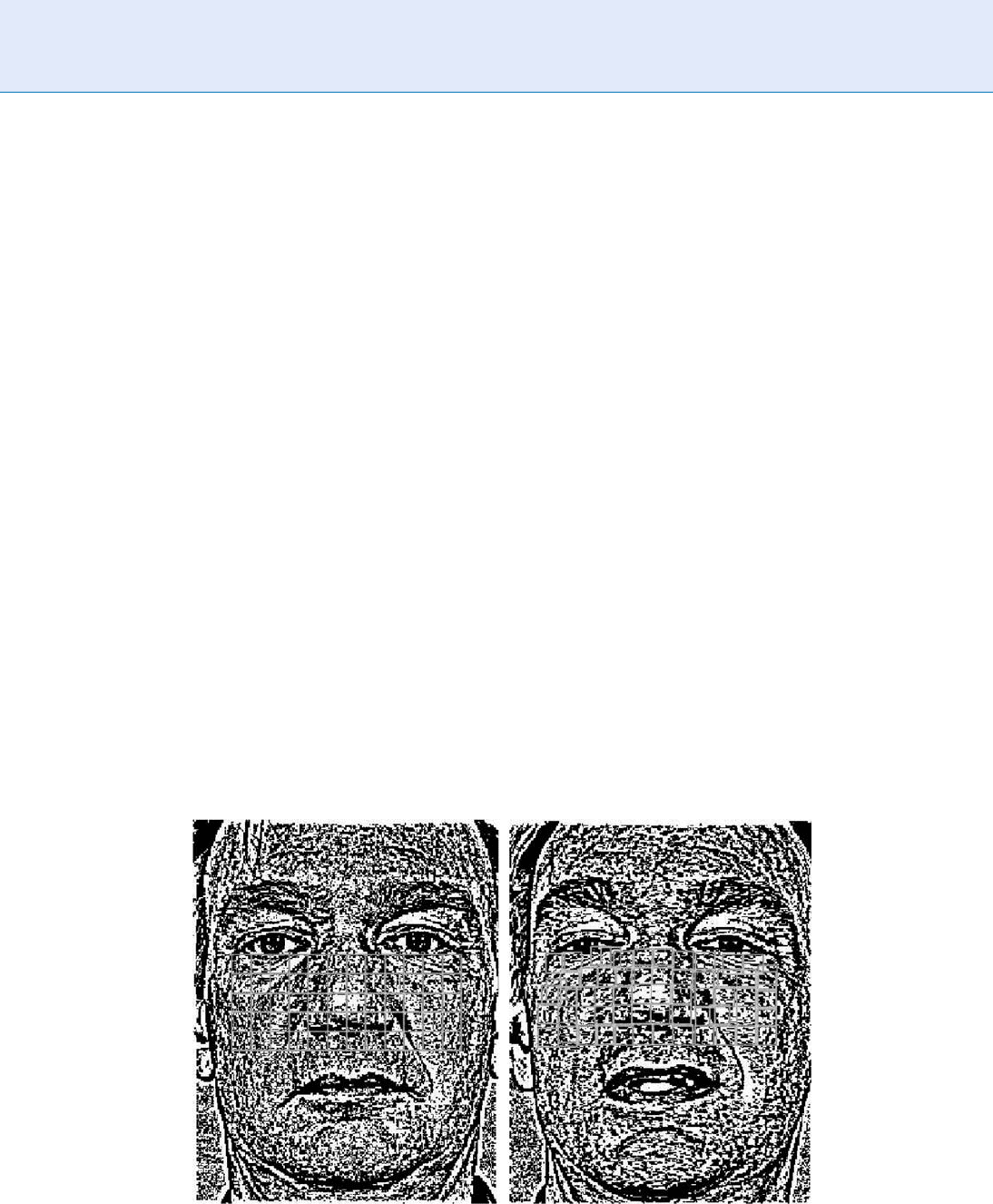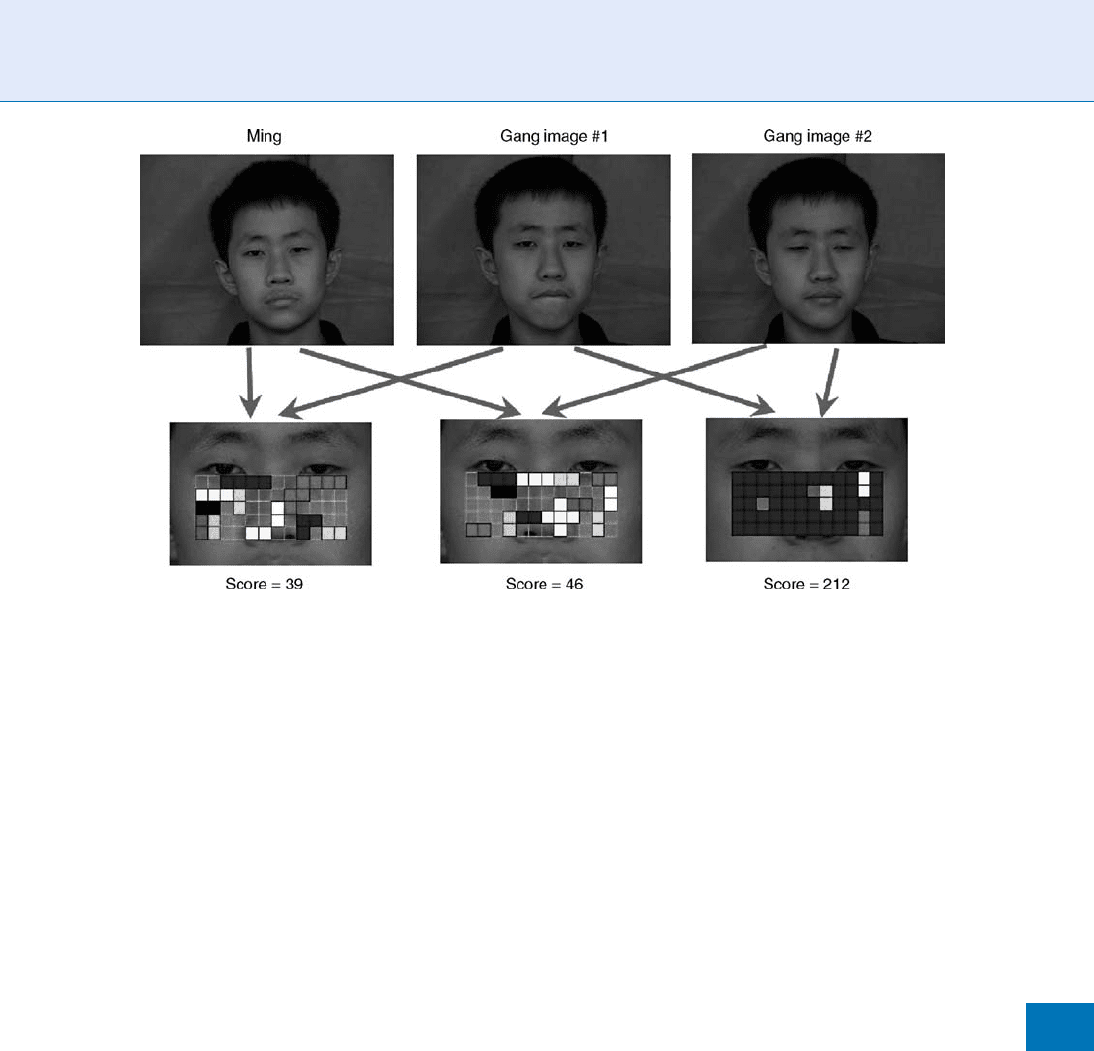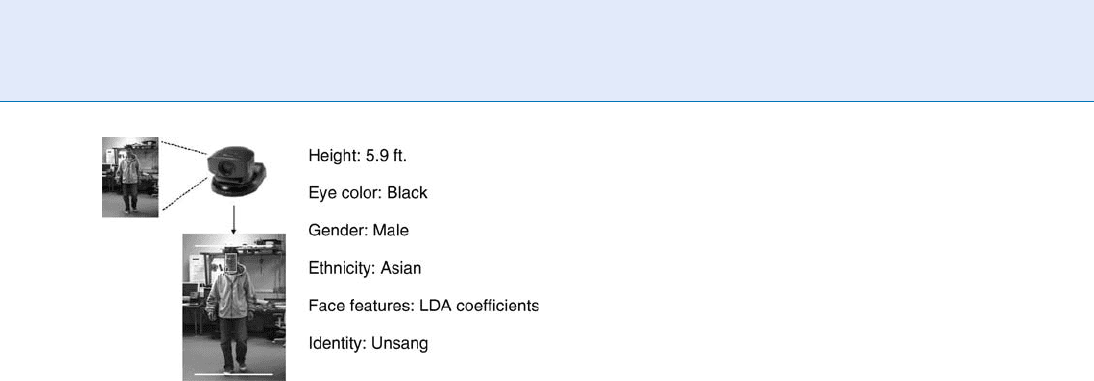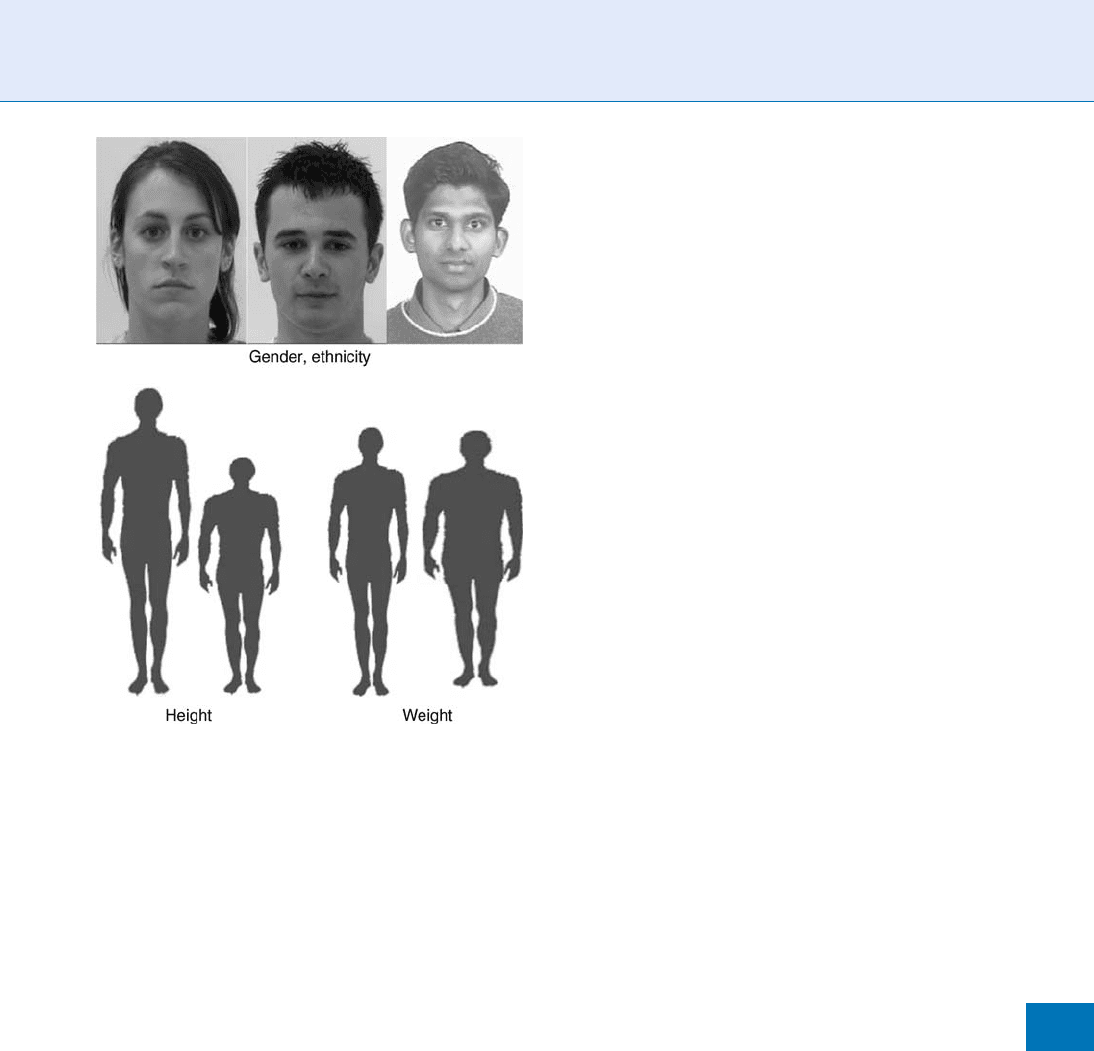Li S.Z., Jain A.K. (eds.) Encyclopedia of Biometrics
Подождите немного. Документ загружается.


This method first defines the average luminance of
each pixel as the average gray scale value of its sur-
rounding pixels. Then the facial images are converted
into binary images by comparing a pixel’s gray scale
value to its average luminance, with one or zero valu e
assigned by such pixel’s average luminance which is
above its gray value by a given margin, as illustrated by
the two feature maps in Fig. 1.
The skin area is then (usually below the eyes
and above the mouth)is div ided into several neighbor-
ing small blocks. For each block in the test image
the algorithm searches, in a local region of its cor-
responding block in the reference image, for the best
matching position. Figure 2 shows the matching results
of id entical twins, Ming and Gang , using Delean’s
Method. The upper row is one image of Ming and
two images of Gang. The lower row gives the pairwise
matching results and the corresponding similarity
scores. We use different colors to mark the continuous
regions after searching process. Same color indicates
that the neighbhoring blocks relative position change
is below a given threshold and they are considered as
continuous. More continuous block pairs implies that
the two images are likely to belong to a same person.
The probability can be formulated as a function of the
number of continuous block pairs. The underlying
assumption behind this method is: With two images
of a same person, the be st matching positions of the
neighboring blocks in the reference image tend to keep
the relative position of the blocks in the test image.
Otherwise, with two images of di fferent persons, the
relative position will not be kept. Finally the method
takes advantage of the continuity of block pairs and the
relative location of neighboring blocks to compute the
similarity score (Fig. 1).
The method is usually used as a complementary
to the other face matching algorithms rather than on
its own. Indentix reported that the incorporation of
the skin texture method into a local feature analysis
(LFA) matcher [3] could increase its accuracy by
20–25%. It was also reported [4] that this method
could differentiate between identical twins.
The Neven Vision method [5] uses Elastic Bunch
Graph [6] to represent faces and is capable of placing
this graph w ith hig h precision on a face in a presented
image. Based on the found facial landmarks, cor-
responding to facial landmarks like eye corner or the
tip of the nose, it first accurately locates the areas
in the face that are used for skin texture analysis. The
skin areas are then warped and normalized before
matching. In the matching step, for each selected skin
patch, the feature vector is matched individually to the
face region of reference image and the most similar
skin patch is identified. The result is a more or less
distorted version of the graph in the original image.
From the similarity and distortion between the original
Skin Texture. Figure 1 Left: the blocks in a gallery skin texture image. Right: the best matching positions in a probe skin
texture image.
1230
S
Skin Texture

graph and the matched graph, a similarity score is
computed incorporating local geometric constraints
[5]. Having achieved an impressive performance in
FRVT2006 [7], Neven Vision also claims that their
skin texture analysis is about 1,000 times faster than
the Delean/Identix algorithm. This method works on
very high resolution images with inter-pupil distance
of at least about 600 pixels. When this condition is
fulfilled, it can achieve better recognition accuracy
than iris-based method and can even outperform
human performance [7].
Pros and Cons
Skin texture based methods have the following
advantages:
The facial skin has a fine texture that is determined
randomly during embryonic gestation. Even iden-
tical monozygotic twins have completely indepen-
dent skin textures.
The acquisition of skin texture is similar to captur-
ing a photograph, and can be perf ormed from
several meters away. There is no need for the person
to be identified to touch any equipment that has
recently been touched by a stranger, thereby elim-
inating an objection that has been raised in some
cultures against finger-print scanners, where a
finger has to touch a surface, or retinal scanning,
where the eye can be brought very close to a lens.
Skin texture contains plentiful local detailed infor-
mation and can achieve a very high recognition
accuracy.
However, they have the following disadvantages:
High resolution is of vital importance for skin
texture based methods. The performance will dra-
matically drop with blurred images because the
image resolution is reduced.
Skin texture may not be the same w ith aging, exag-
gerative expression, pose variation, and illumina-
tion changes.
In surveillance environment, it is difficult to cap-
tain high resolution face images at a far distance if
the person to be identified is not cooperative by
holding the head still and looking at the camera.
This may narrow possible applications of skin
texture methods.
Summary
As a new method for biometrics, skin texture has
demonstrated its effectiveness in identifying indivi-
duals in high resolution images. The increased demand
for accurate, reliable, fast, and convenient biometric
Skin Texture. Figure 2 An example of Delean’s method in matching of twins.
Skin Texture
S
1231
S

technologies, and availability of inexpensive comput-
ing resources and cameras will all benefit to the rapid
technical advances in thi s direction. Although there
are several unsolved problems and disadvantages as
aforementioned, the skin texture method is surely
of significance from both application and research
perspectives.
Related Entries
▶ Face Recognition
▶ Local Image Features
▶ Skin Spectroscopy
References
1. Cula, O., Dana, K., Murphy, F., Rao, B.: Skin Texture Modeling.
Int. J. Comput. Vis. 62(1–2), 97–119 (2005)
2. Delean, B., Escolls, R.: Method and apparatus for probabilistic
image analysis. u.s. patent application publication no. 2004/
0052418 (2004)
3. Penev, P., Atick, J.: Local feature analysis: a general statistical
theory for object representation. Network: Comput. Neural Syst.
7(3), 477–500 (1996)
4. Identix Turbo charges its Biometric Engineers, Biometric Tech-
nology Today, ISSN 0969-4765/04, 12(4), 1,12 (April 2004).
5. Adam, H., Neven, H., Steffens, J.: Single image based multi-
biometric system and method u.s. patent application publica-
tion no. 2006/0050933 (2006)
6. Wiskott, L., Fellous, J., Kruger, N., Malsburg, C.: Face recogni-
tion by elastic bunch graph matching. IEEE Trans. Pattern Anal.
Mach. Intell. 19(7), 775–779 (1997)
7. Phillips, P., Scruggs, W., O’Toole, A., Flynn, P., Bowyer, K.,
Schott, C., Sharpe, M.: Frvt 2006 and ice 2006 large-scale results
(2007)
Skull, Forensic Evidence of
MIN GQUA N ZHOU
Beijing Normal University, Beijing, China
Synonyms
Craniofacial reconstruction; Skull-photo superimposi-
tion; Craniofacial superimposition
Definition
Forensic evidence of skull is the technique of obtaining
the identi ty of a person based on attributes associated
with an individual skull. Generally, the methods of
determining the identity of a given skull can be classi-
fied into two categories: craniofacial reconstruction,
which reconstructs the facial appearance from a given
skull based on the assumed relationship between the
soft tissue envelope and the underlying skull substrate
[1, 2] and skull-photo superimposition or craniofacial
superimposition, which superimposes the skull and
face photo in a certain way to verify whether they are
from the same person, by comparing their feature
points [3].
Introduction
In forensic pathology, it is esse ntial to determine
the identity of the dead. However, in many instances,
due to the storage environment and discovery time
of the corpse, the soft tissue becomes highly
decomposed, and forensics cannot determine the ap-
pearance of the dead directly. As a result, attempts
have been made to reconstruct the appearance from
the remaining skeletons, especially the skull. Research
has revealed that there are certain relationships be-
tween the facial soft tissue and the skull, and the skull
has evident influence on the shape, location and struc-
ture of the facial soft tissue. Thus, the facial appearance
is related to the skull to a certain extent, and it ensures
the fidelity of the forensic evidence of skull [4, 5].
To determine the identity of a skull, an option is
to reconstruct the 3D facial appearance explicitly or
implicitly. The former is known as craniofacial recon-
struction, which reconstructs the 3D facial appearance
based on the given skull. Face is the most expressive
part of the human being. Reconstructing a realistic
3D facial appearance is a challenging task. The latter
method referred to as skull-photo superimposition
does not reconstruct the 3D facial appearance explicit-
ly. Instead, it superimposes the skull and photo at the
same imaging condition to check whether the given
skull and photo are of the same person, by matching
their feature points. As in the case of fingerprint
and tooth-based inspection, skull-photo superi mposi-
tion-based inspection can also verify the identity, and
is an important method in
▶ forensic anthropology.
1232
S
Skull, Forensic Evidence of

In cases where the body is dismembered, skull-photo
superimposition becomes even more important and
unique in identity verifications. DNA can be of valu e
in these cases and even when only the bones remain.
Craniofacial Reconstruction
Traditionally, craniofacial reconstruction methods can
be classified into 2D reconstruction and 3D recon-
struction. In 2D reconstruction, the hand drawn
portrait of the dead is viewed by experienced anthro-
pologists, art ists or forensics based on the skull. 3D
reconstruction methods normally set so me marker
points with height on the skull model, and use clay as
a replacement of soft tissue, to shape the facial appear-
ance based on the skull according to anatomical
knowledge. However, these traditional reconstruction
methods have several limitations:
1. The who le process is very time-consuming, it
takes almost a month to reconstruct a person’s
appearance.
2. The result relies heavily on the expertise and expe-
rience of the reconstructors, the accuracy and reli-
ability of the reconstruction is affected by many
human factors.
3. The soft tissue and shape of the human face is
different for each human race and living environ-
ment, it is favorable to generate several recon-
structed facial appearances simultaneously when
the race of a given skull is not known. Using tradi-
tional reconstruction methods, however, only one
appearance for one race can be obtained.
4. It is difficult to edit or modify the reconstructed
facial appearance once it is complete.
In the past decades, however, imaging technologies
like
▶ CT and MRI have been applied to convert the
skull into digital data so that it can be stored and
processed easily, leading to computer-aided craniofa-
cial reconstruction. In a typical computer-aided cra-
niofacial reconstruction system, the relationship
between the skull and soft tissue is not determined by
the expertise and experience of the reconstructors.
Instead, the relationship is learnt from the training
data, which are reference pairs of captured skull data
and soft tissue data. The knowledge of obtaining facial
detail from the skull and the distribution law of the soft
issues are obtained through feature point pairs on the
skull and face appear ance. This guides the creation of
an individual skull. Traditio nally, several methods are
available to obtain the training samples of reference
skull data and soft tissue data, for example, using
▶ acupuncture on the dead body to measure the thick-
ness of the soft tissue. Following advances in imaging
technologies, CT technologies may be used to collect
training data for craniofacial reconstruction more ac-
curately and efficiently. A pre-processing step, typically
consisting of filtering and geometric transform a-
tion, is performed to eliminate the noise in each
2D CT slide and align the slides correctly [6, 7].
Sometimes, to facilitate 3D reconstruction of skull
and face, edge detection and edge tracking is per-
formed on the 2D CT slides to extract the contour
curves in each slide [8–10]. After pre-processing, 3D
reconstruction of the skull and face can be undertaken
to generate the training samples for the craniofacial
reconstruction system. In some systems, an explicit
model describing the relationship between the skull
and soft tissue is built from the training samples.
Along with the development of statistical learning
theor y, some systems instead reconstruct 3D facial
appearance directly from a given skull by using statis-
tical learning methods, without developing an explicit
model describing the knowledge of these training
samples. However, though craniofacial reconstruction
can be used as an auxiliary method to aid detectives
in their work, its result cannot be used as legal evi-
dence in a court of law.
Craniofacial reconstruction can also be used in
▶ palaeoanthropology, for example, to reconstruct
the facial appearance of famous anci ent people accord-
ing to their skull, in order to see how these people
looked and compare it with their portraits. Further,
Craniofacial reconstruction can be used in facial sur-
ger y to help simulate the process and effect of the
surgery, providing a more detailed and accurate sur-
ger y plan, and reducing the risk of operation.
Skull-photo Superimposition
Skull-photo superimposition was first developed to
verify the fidelity of portraits of ancient notables. In
the 1980s doubts were raised about the authenticity of
many of the portraits as it was believed that the pain-
ters wanted to please these notables. To verify this
conjecture, anatomists compared the skulls and
Skull, Forensic Evidence of
S
1233
S

portraits of notables. However, the earliest attempts to
use the skull for identity verification in literature were
made at the end of the 19th century by Schau Ffhausen,
Von Froliep and other scientists. In 1935 Brash
recorded the first successive use of craniofacial super-
imposition as forensic evidence in the Ruxton case.
Since then, along with the development of photo-
graphic and video technolo gies, many improvements
and upgrades have been made by researchers. In the
last 20 years, researchers have extended craniofacial
superimposition from photographic superimposition
to video superimposition, which has proven to be a
successful craniofacial identification.
A typical skull-photo superimposition operation
can be separated into the following stages: First, the
skull data is obtained through a 3D scanner or recon-
structed from CT scans. After collecting the 3D skull
data, the difference between locations, sizes and orien-
tations of the skull and photo need to be minimized
for the superimposition task. As the photo is difficult
to manipulate in three-dimension, the skull is nor-
mally edited or adjusted in three-dimension to be
aligned with the photo. Moreover, the facial photo
may need to exposed to several pre-processing steps
such image enhancement, scaling, and rotation [6, 7].
Next, facial features including head contour curves
are extracted from the facial photo [8–10]. In the
next stage marker points are selected, the traditional
method of manual selection relies on the expertise
of operators, and the result tends to be erroneous.
On the other hand, despite the recent advances in
computer vision, a fully automatic method of marker
points selection is not realistic at the current stage.
In practice, a hybrid system of combining manually
labeling and computer verification yields a reason-
able result. Finally, skull-photo registration techniques
and standardized verification process are performed
to verify the identit y [11–14]. Unlike craniofacial
reconstruction, skull-photo superimposition opera-
tions, if performed well, can be used as legal evidence
in court.
Related Entries
▶ Biometrics, Overview
▶ Forensic DNA Evidence
▶ Identification
▶ Verification
References
1. Prag, J., Neave, R.: Making Faces Using Forensic and Archaeo-
logical Evidence. British Museum Press, UK (1997)
2. Taylor, K.T.: Forensic Art and Illustration. CRC Press, New York
(2001)
3. Dorion, R.: Photographic superimposition. JFSCA. 28(3),
724–734 (1983)
4. Wilkinson, C.: Forensic Facial Reconstruction. Cambridge
University Press, Cambridge (2004)
5. Stephan, C., Henneberg, M.: Building faces from dry skulls: Are
they recognized above chance rates? J. Forensic. Sci. 46(3),
432–440 (2001)
6. Hummel, A.D.: Image enhancement by histogram transforma-
tion. Comput. Graph Image Process. 6(2), 184–195 (1977)
7. Ketcham, D.J.: Real-time image enhancement technique.
In: Proceeding SPIE/OSA, Conference on Image Processing,
pp. 120–125. Pacific Grove, CA (1976)
8. Kass, M., Witbin, A., Tetzopoulos, D.: Snake: Active contour
model. Int. J. Comput. Vis. 1(4), 321–331 (1988)
9. Lai, K.F., Chin, R.T.: Deformable contours modeling and extrac-
tion. IEEE Trans. Pattern Anal. Mach. Intell. 17(11), 1084–1090
(1995)
10. Gunn, S.R., Nixon, M.S.: Snake head boundar y extraction
using global and local energy minimization. Proceeding of
international conference on pattern recognition (ICPR ’96),
pp. 581–585. Vienna, Austria (1996)
11. Besl, P., McKay, N.: A method for registration of 3-D shapes.
IEEE Trans. Pattern Anal. Mach. Intell. 14(2), 239–256 (1992)
12. Pelizarri, C.A., Chen, G., Spelbring, D.: Accurate three-dimen-
sional registration of CT, PET, and/or MRI images of the brain.
J. Comp. Assist. Tomogr. 13(1), 20–26 (1989)
13. Wells, W.M., Viola, P., Atsumi, H., Nakajima, S., Kikinis, R.:
Multi-modal volume registration by maximization of mutual
information. Med. Image Anal. 1(1), 35–51 (1996)
14. Vandermeulen, D., Collignon, A., Michiels, J., Bosmans, H.,
Suetens, P., Marchal, G.: Multi-modality image registration
within covira. Med. Image-Anal. 19, 29–42 (1995)
Skull-Photo Superimposition
▶ Skull, Forensic Evidence of
Slap Or Four-Four-Two device
It refers to a device used to capture the ten finge rprints
of a person using the following capture sequence:
1234
S
Skull-Photo Superimposition

simultaneous capture of the four fingers (index, mid-
dle, ring, and little finger) of one hand, simultaneous
capture of the four finge rs of the other hand, and
simultaneous capture of the two thumbs. A segmenta-
tion algorithm is needed to detect and separate the
finger in ten single images.
▶ Fingerprint, Palmprint, Handprint and Soleprint
Sensor
Smart Cameras
Smart cameras are cameras that along with the sensor
have additi onal processing elements (micro-control-
lers, DSP) for processing data on-site. The results of
the processing are then transmitted to other nodes in
the network. Smart cameras form an important part of
the distributed computing idea, as only the relevant
information from each camera is transmitted to other
cameras/central processing agency. This alleviates the
burden on other nodes to replicate the processing as
well as the need for superior computing resources at a
central node.
▶ Surveillance
Smart Card
A smart card is a small plastic card with an embedded
microchip that can store and/or process information.
It can receive and submit data to or from any system
equipped with an appropriate card-reader module. In
commercial hand-geometry devices, for example,
smart cards are often used as storage media for user-
templates and as such eliminate the need for storing
templates in the internal memory of the device. Its
synonyms include integrated circuit card (IC C) and
chip card.
▶ Hand-Geometry Device
▶ Tamper-proof Operati ng System
Soft Biometrics
KARTHIK NANDAKUMAR
1
,ANIL K. JAIN
2
1
Institute for Infocomm Research, A*STAR,
Fusionopolis, Singapore
2
Michigan State University, East Lansing, MI, USA
Synonyms
‘‘Light’’ biometrics
Definition
Any anatomical or behavioral characteristic that pro-
vides some information about the identity of a person,
but does not provide sufficient evidence to precisely
determine the identity can be referred to as a soft
biometric trait. Personal attributes like gender, ethnicity,
age, height, weight, eye color, scars, marks, tatoos, and
voice accent are examples of soft biometric traits. Soft
biometric information complements the identity infor-
mation provided by traditional (primary) biometric
identifiers such as fingerprint, face, iris, and voice.
Hence, utilizing soft biometric traits can improve the
recognition accuracy of primary biometric systems.
Introduction
Systems that consolidate evidence from multiple sources
of biometric information (e.g., face, fingerprint, hand
geometry, iris, etc.) in order to reliably determine the
identity of an individual are known as multibiometric
systems [1]. Multibiometric systems can alleviate many
of the limitations of unibiometric systems such as
nonuniversality and lack of distinctiveness, thereby
reducing the error rates significantly. However, using
multiple biometric traits will increase the enrollment
and verification times, cause more inconvenience to
the users, and increase the overall cost of the system.
An alternate way for reducing the error rates of the
biometric system without causing any additi onal in-
convenience to the user is to incorporate soft identi-
fiers of human identity like gender, ethnicity, height,
eye color, etc. into a (primary) biometric recognition
system [2]. Figure 1 depicts a scenario where both
primary (face) and soft (gender, ethnicity, height, and
Soft Biometrics
S
1235
S

eye color) biometric information can be automati-
cally extracted and utilized to verify an user’s identity.
In this scenario, the height of the user can be estimated
as he approaches the camera and his age, gender,
ethnicity, and eye color can be estimated from his
face image. These additional attributes can be used
along with the face biometric to accurately identify
the person.
Motivation for Utilizing Soft Biometric
Traits
The usefulness of soft biometric traits in improving
the performance of the primary biometric system
can be illustrated by the following example. Consider
three users A (1.8 m tall, male), B (1.7 m tall, female),
and C (1.6 m tall, male) who are enrolled in a finger-
print biometric system that works in the identifica-
tion mode. Suppose user A presents his fingerprint
sample X to the system, it is compared to the templates
of all the three users stored in the database and the
posteriori matching probabilities of all the three users
given the sample X are calculated. Assume that the
outputs of the fingerprint matcher are P(AjX) ¼ 0.
42, P(BjX) ¼ 0.43, and P(CjX) ¼ 0.15. In this case,
user A will be falsely identified as user B based
on the Bayesian decision rule. However, assume that
as the user approaches the fingerprint sensor, there
exists a secondary system that automatically identi -
fies the gender of the user as male and measures the
user’s height as 1.78 m. This information, in addition
to the posteriori matching probabilities given by the
fingerprint matcher, is likely to lead to a correct iden-
tification of the user as user A.
The first biometric system developed by Alphonse
Bertillon in 1883 used anthropometric features such as
the length and breadth of the head and the ear, length of
the middle finger and foot, height, etc. along with attri-
butes like eye color, scars, and tatoo marks for ascertain-
ing a person’s identity. These measurements were
obtained manually by Bertillon. Although each individ-
ual measurement in the Bertillonage system may exhibit
some (intra-user) variability, a combination of several
quantized (or binned) measurements was sufficient to
manually identify a person with reasonable accuracy.
The Bertillon system was dropped in favor of the Henry’s
system of fingerprint identification over 100 years back
due to three main reasons: (1) lack of persistence – the
anthropometric features (e.g., height) can vary signifi-
cantly for juveniles; (2) lack of distinctiveness – features
such as skin color or eye color cannot be used for distin-
guishing between individuals coming from a similar
ethnic background; and (3) the huge time, effort, and
training required to get reliable measurements.
While the anthropometric features used in the
Bertillon system provide some information about the
identity of the user, they are not sufficient for accurately
identifying the user. Hence, these attributes can be
referred to as ‘‘soft biometric traits’’. Figure 2 shows
some examples of soft biometric traits. Since the soft
biometric information complements the identity infor-
mation provided by traditional (primary) biometric
identifiers such as fingerprint, face, iris, and voice, utiliz-
ing soft biometric traits can improve the recognition
accuracy of primary biometric systems. Many practical
biometric systems collect soft biometric information
about the users during enrollment. For example, the
fingerprint card used by the Federal Bureau of Investiga-
tion (FBI) includes information on the gender, ethnicity,
height, weight, eye color, and hair color of the person
along with the prints of all ten fingers. However, the
searches in the FBI Automated Fingerprint Identification
System (AFIS) are solely based on fingerprints and the
potentially useful soft biometric information is either
ignored during the search or used only for manual
verification after a short list of potential fingerprint
matches is identified. If the soft biometric characteristics
can be automatically extracted and/or utilized during the
automated matching process, the overall accuracy of the
system will improve and the need for manual interven-
tion will be reduced.
Soft Biometrics. Figure 1 A scenario where the primary
biometric identifier (face) and the soft biometric attributes
(gender, ethnicity, eye color and height) are automatically
extracted and utilized to verify a person’s identity.
1236
S
Soft Biometrics

Challenges in Using Soft Biometrics
Two key challe nges need to be addressed to incorporate
the soft biometric information into the traditional
biometric framework. The first challenge is the auto-
matic and reliable extraction of soft biometric informa-
tion in a nonintrusive manner, without causing any
inconvenience to the users. It must be noted that the
failure of Bertillon-like systems was caused by the
unreliability and inconvenience in the manual extrac-
tion of these features. Once the soft biometric infor-
mation about a user is available, the challenge is to
optimally combine this information with the
▶ primary
biometric identifier so that the overall recognition ac-
curacy is enhanced. While soft biometric traits can be
used for
▶ filtering a large database or for tuning the
parameters of a biometric system, such applications
require a highly accurate soft biometric feature extrac-
tion module. Since it is very difficult to extract soft
biometric features with 100% accuracy, the information
fusion system needs to be designed in such a way that
the overall recognition accuracy is enhanced even when
the soft biometric feature extraction is not perfect.
Automatic Soft Biometric Feature
Extraction
Soft biometric traits are available and can be extracted in
a number of biometric applications. For example, attri-
butes like gender, ethnicity, age, and eye color can be
extracted with sufficient reliability from the face images.
Automatic recognition of gender has been extensively
studied and a majority of the gender recognition sys-
tems proposed in the literature are based on frontal face
images. Furthermore, most of the these systems follow
an appearance-based approach to gender recognition
(see [3, 4] and the references therein). The face images
are typically cropped to include only the forehead, eyes,
nose, and mouth regions, and normalized for pose and
illumination changes. A pattern classifier is directly
trained using the normalized face images to learn the
decision boundary between the male and female classes.
The accuracy of face-based gender recognition systems
is typically around 90% when presented with good
quality frontal face images. Some of the techniques
used for gender recognition can also be applied to
classify people based on their ethnicity [3, 5].
Automatic age determination is a more difficult
problem than gender classification. Kwon and Lobo
[6] presented an algorithm for age classification
from facial images based on cranio-facial changes in
feature-position ratios and skin wrinkle analysis. More
recently, Lanitis et al. [7] performed a quantitative
evaluation of the performance of various classifiers
developed for the task of automatic age estimation
from face images. All the classifiers used eigenfaces
obtained using
▶ principal component analysis
(PCA) as the input features. Quadratic models, short-
est distance classifier, neural network classifiers, and
hierarchical classifier were used for estimating the age.
The best age estimation algo rithm had an average
absolute error of 3.82 years, which was comparable to
the error made by humans (3.64 years) in performing
the same task. Geng et al. [8] proposed an iterative
learning algorithm known as AGES for age estimation
from PCA features. The AGES algorithm achieved a
mean absolute error of 6.77 years in estimating the age
on a database with 1,002 face images obtained from
82 subjects.
Soft Biometrics. Figure 2 Examples of soft
biometric traits.
Soft Biometrics
S
1237
S

Gender, speech accent, and perceptual age of the
speaker can also be inferred from the speech signal.
The weig ht of an user can be measured by asking him
to stand on a weight sensor while he is providing his
primary biometric. Ailisto et al. [9] used body fat
measurement as a soft biometric trait. The height of
a person can be estimated from a real-time sequence
of images as the user approaches the biometric system.
Jain et al. [2] implemented a real-time vision system for
automatic extraction of gender, ethnicity, height, and
eye color. The system was designed to extract the
soft biometric attributes as the person approaches
the primary biometric system to present his primary
biometric identifier (face and fingerprint). Their soft
biometric system is equipped with two pan/tilt/zoom
cameras. Camera 1 monitors the scene for any human
presence based on the motion segmentation image.
Once camera 1 detects an approaching person, it mea-
sures the height of the person and then guides camera
2 to focus on the person’s face.
Fusion of Primary and Soft Biometric
Information
Jain et al. [2] developed a Bayesian framework for
fusion of primary and soft biometric features. The
main advantage of this framework is that it does
not require the soft biometric feature extractors to be
perfect (100% accurate). Assume that the primary
biometric system is based on R
p
(R
p
1) biometric
identifiers like finge rprint, face, iris, and hand geome-
try. Further, the soft biometric system is based on
R
s
(R
s
1) attributes like age, gender, ethnicity, eye
color, and height. Let o
1
, o
2
, ..., o
M
represent the M
users enrolled in the database. Let x ¼½x
1
; x
2
; ...; x
R
p
be the collection of primary biometric feature vectors.
Let p(x
j
jo
k
) be the likelihood of observing the primary
biometric feature vector x
j
given the user is o
k
.If
the output of each individual modality in the pri-
mary biometric system is a set of match scores,
s
k
¼½s
1;k
; s
2;k
; ...; s
R
p
;k
, one can appro ximate p(x
j
jo
k
)
by p(s
j
jo
k
), provided the genuine match score distri-
bution of each modality is known.
Let y ¼½y
1
; y
2
; ...; y
R
s
be the soft biometric fea-
ture vector, where, for example, y
1
could be the gender,
y
2
could be the eye color, etc. The posteriori probability
of user o
k
given both x and y can be calculated by
applying the
▶ Bayes rule as follows:
Pðo
k
jx; yÞ¼
pðx; yjo
k
ÞPðo
k
Þ
pðx; yÞ
; ð1Þ
where P(o
k
) is the prior probability of observing user
o
k
. If all the users are equally likely to access the system
and if all the primary biometric feature vectors
x
1
; ...; x
R
p
and all the soft biometric variables
y
1
; y
2
; ...; y
R
s
are independent of each other given
the user’s identity o
k
, the discriminant function,
g
k
(x, y), for user o
k
, can be computed as
g
k
ðx; yÞ¼
X
R
p
j¼1
log pðx
j
jo
k
Þþ
X
R
s
r¼1
log pðy
r
jo
k
Þ: ð 2Þ
During the identification phase, the input biomet-
ric sample is compared with the templates of all the M
users enrolled in the database and the discriminant
functions g
1
, ..., g
M
are computed. The test user is
identified as that user with the largest value of discrim-
inant function among all the enrolled users. A simple
method for computing the soft biometric likelihoods
p(y
r
jo
k
),r ¼ 1, 2, ...,R
s
, k ¼ 1, 2, ..., M is to estimate
them based on the accuracy of the soft biometric
feature extractors. Jain et al. [2] also suggested the
use of a scaling factor b
r
,0 b
r
1, to flatten the
likelihood distribution of each soft biometric trait.
The scaling factor b
r
can act as a measure of the
reliability of the rth soft biometric feature and its
value can be set depending on the environment (hos-
tile or friendly) in which the system operates.
Summary
In addition to the match scores provided by the bio-
metric matchers, ancillary information may also be
available to a biometric system. Soft biometric char-
acteristics like gender, ethnicity, height, and weight
provide some information about the identity of the
user. Although the soft biometric information alone
is not sufficient for accurate recognition, they can be
used to complement the information provided by the
primary bio metric identifiers like fingerprint, iris, and
face. Techniques for automatically extracting soft bio-
metric information have been developed only recently.
Hence, fusion schemes that incorporate such ancillary
information have not been thoroughly explored and
there is a large scope for conducting more in-depth
research in this area.
1238
S
Soft Biometrics

Related Entries
▶ Biometrics, Overview
▶ Biometric Fusion
▶ Face Recognition
▶ Fingerprint Recognition
▶ Multibiometrics
References
1. Ross, A., Nandakumar, K., Jain, A.K.: Handbook of Multibio-
metrics. Springer, Berlin (2006)
2. Jain, A.K., Nandakumar, K., Lu, X., Park, U.: Integrating faces,
fingerprints and soft biometric traits for user recognition.
In: Proceedings of ECCV International Workshop on Bio-
metric Authentication (BioAW), vol. LNCS 3087, pp. 259–269.
Springer, Prague, Czech Republic (2004)
3. Gutta, S., Huang, J.R.J., Phillips, P.J., Wechsler, H.: Mixture
of experts for classification of gender, ethnic origin, and
pose of human faces. IEEE Trans. Neural Netw. 11(4), 948–960
(2000)
4. Moghaddam, B., Yang, M.H.: Learning gender with support
faces. IEEE Trans. Pattern Anal. Mach. Intell. 24(5), 707–711
(2002)
5. Lu, X., Jain, A.K.: Ethnicity identification from face images. In:
Proceedings of SPIE Conference on Biometric Technology for
Human Identification, vol. 5404, pp. 114–123. Orlando, USA
(2004)
6. Kwon, Y.H., Lobo, N.V.: Age classification from facial images. In:
Proceedings of IEEE Conference on Computer Vision and
Patern Recognition, pp. 762–767 (1994)
7. Lanitis, A., Draganova, C., Christodoulou, C.: Comparing dif-
ferent classifiers for automatic age estimation. IEEE Trans. Syst.
Man Cybern. Part B: Cybern. 34(1), 621–628 (2004)
8. Geng, X., Zhou, Z.H., Zhang, Y., Li, G., Dai, H.: Learning from
facial aging patterns for automatic age estimation. In: Proceed-
ings of the 14th Annual ACM International Conference on
Multimedia, pp. 307–316. Santa Barbara, USA (2006)
9. Ailisto, H., Vildjiounaite, E., Lindholm, M., Mkel, S.M.,
Peltola, J.: Soft biometrics - combining body weight and fat
measurements with fingerprint biometrics. Pattern Recognit.
Lett. 27(5), 325–334 (2006)
Soleprint Device
▶ Fingerprint, Palmprint, Handprint and Soleprint
Sensor
Soleprint Sensor
▶ Fingerprint, Palmprint, Handprint and Soleprint
Sensor
Sound
Sound is a pressure wave which is created by a vibrat-
ing object.
▶ Speech Production
Sound Generation
▶ Speech Production
▶ Voice Sample Synthesis
Sources of Evidence
▶ Sources of Information in Biometric Fusion
Sources of Information in Biometric
Fusion
ARU N ROSS
Lane Depar tment of Computer Science and Electrical
Engineering, West Virginia University, Morgantown,
WV, USA
Synonyms
Sources of evidence
Definition
Multibiometric systems rely on the evidence presented
by multiple sources of biometric information. Based on
Sources of Information in Biometric Fusion
S
1239
S
